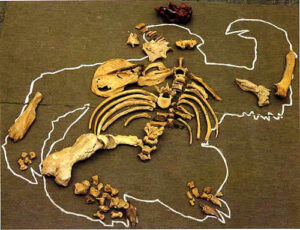 One of the many mysteries we have about the sloth site is why we have so many more bones from the right side than left side of the adult. (The photo (below) is misleading—it comes from an outreach program where we had to spread the bones out so that viewers on the “bad” side had something to look at. The real difference isn’t absolute, but it’s striking.) There’s no intrinsic reason why the bones on one side of the sloth should have fossilized better than the other, so it must indicate something about the conditions near the time of death. (photo borrowed from)
One of the many mysteries we have about the sloth site is why we have so many more bones from the right side than left side of the adult. (The photo (below) is misleading—it comes from an outreach program where we had to spread the bones out so that viewers on the “bad” side had something to look at. The real difference isn’t absolute, but it’s striking.) There’s no intrinsic reason why the bones on one side of the sloth should have fossilized better than the other, so it must indicate something about the conditions near the time of death. (photo borrowed from)
 Gary Haynes reports that when African elephants die, if they don’t drop in their tracks, most lie down on their left sides (Haynes, 1988). It’s only a “strong . . . impression,” though, and he hasn’t a clue why it should be. Bones on the “down” side, have a better chance of being covered by water or sediment and protected from scavengers under some circumstances, and they may be more likely then to survive and tell the story of their early taphonomic history. Haynes found a mammoth scattered at a site in Alaska where the transverse processes of the thoracic vertebrae were all heavily gnawed just on their right sides, indicating that the animal fell exactly as predicted (Haynes, 1980).
Gary Haynes reports that when African elephants die, if they don’t drop in their tracks, most lie down on their left sides (Haynes, 1988). It’s only a “strong . . . impression,” though, and he hasn’t a clue why it should be. Bones on the “down” side, have a better chance of being covered by water or sediment and protected from scavengers under some circumstances, and they may be more likely then to survive and tell the story of their early taphonomic history. Haynes found a mammoth scattered at a site in Alaska where the transverse processes of the thoracic vertebrae were all heavily gnawed just on their right sides, indicating that the animal fell exactly as predicted (Haynes, 1980).
Different microenvironments that become established inside a carcass during decomposition could also be a factor. The role of the decay and putrefaction microbes in the process of fossilization is much debated, but there is no doubt that a mega-sized mammal like a sloth creates its own internal environment as it decomposes, with sufficient volume, mass and thermal inertia for the process to proceed for some time independently of external conditions. That’s especially true in the winter without the insects to pierce the skin and interrupt the anaerobic bacteria. Lying on the ground, the “down” side of an animal as big as an adult sloth, removed from the desiccating effects of the sun and wind, or the cold, will stay warm and humid, creating a microhabitat for different microbes to thrive, selectively fostering or hindering the process of fossilization (Coe, 1978).
Presumably anything that put the sloth on its side, and kept it there, would produce the same effect. But, any protection offered by dying on one side versus the other is apt to be fleeting as carnivores will usually roll a carcass over to gain access to the parts underneath. However, large carcasses may be difficult for scavengers to turn. Frison and Todd report it took 15 people pulling on ropes to flip the carcass of a large male African elephant they were butchering, even with the top side defleshed (Frison and Todd, 1986).
Turning over a 1-ton sloth could be difficult too, depending on the scavenger, and impossible in the winter, with one side frozen to the ground. Winter is the time of bounty for most carnivores. Hunger, stress and the snow leave prey vulnerable and relatively plentiful. Under normal circumstances predators can afford to ignore a frozen carcass and go hunting for something still warm and breathing. Consequently, winter carcasses are usually far less utilized than those of the summer dead or killed (Haynes, 1980). Winter weather, access to only half of the adult sloth, and an abundance of other food, may go a long way toward explaining the condition of our adult’s bones and the contrast with those of the juveniles. . . but, is there any way to determine if the sloths died in the winter? . . . Dave
References
Coe, M. 1978. The decomposition of elephant carcasses in the Tsavo (East) National Park, Kenya. Journal of Arid Environments 1: 71-86.
Frison, GC and Todd, LC. 1986. The Colby mammoth site: taphonomy and archaeology of a Clovis kill site in northern Wyoming. University of New Mexico Press, Albuquerque, 238 pp.
Haynes, G. 1980. Evidence of carnivore gnawing on Pleistocene and recent mammalian bones. Paleobiology 6: 341-351.
Haynes, G. 1988. Longitudinal Studies of African elephant death and bone deposits. Journal of Archaeological Science 15: 131-157.

Pollen samples from the soil around the bones might give info on the season of death. Any plant debris in the teeth? Or if it died in the water -could it have ingested something microscopic that would give clues about what time of year it died? Wasn’t there something a while back about diatoms in the bones?
Hi Pete, I’m working on a post about Jim Huber’s preliminary pollen analysis right now, but since it’s a sample from the sediments around the bones, it’s an average and not a snapshot from the time of death. Plant phytolyths are a good idea. No one has looked. I don’t know how firmly they get embedded–if they are semi-permanent or transitory. Diatoms might show seasonal differences but I gather any that end up in the bones are there permanently and could have found there way there any time while the sloth was alive (assuming we could prove they got there in life and weren’t post-mortem). Art Bettis at the UI has a grad student doing a preliminary screening of the sediments for other microfossils. I’m hoping some insects show up. Then we’ll have to figure out where insects might have settled while they were doing their grisly decomposing business and might have been preserved. Forensic scientists have a long history of using insects to estimate time of death. Something I’ll want to write about if Art finds any.
Strange. I’ve felt at times in the past that I ended up seeing more bones from the left than right sides when I’m in museum collections. But that in itself is an odd preservational bias as I’m looking for the best and most complete elements, which end being lefts.
Dear Dave,
I’m very grateful to you for the African Elephant information you have featured here.
The reason being that I am looking onto large animal decomposition – from point of death to diagenesis – for a TV idea I am developing. After lots of searching and imminent deadlines, I still haven’t been able to find a copy of Coe’s 1978. The decomposition of elephant carcasses in the Tsavo (East) National Park, Kenya. article.
Our local university library doesn’t stock the journal either. Do you happen to know where I could find a copy? Or might you be able to email me a pdf / word doc?
Thank you so much.
Kate Harding